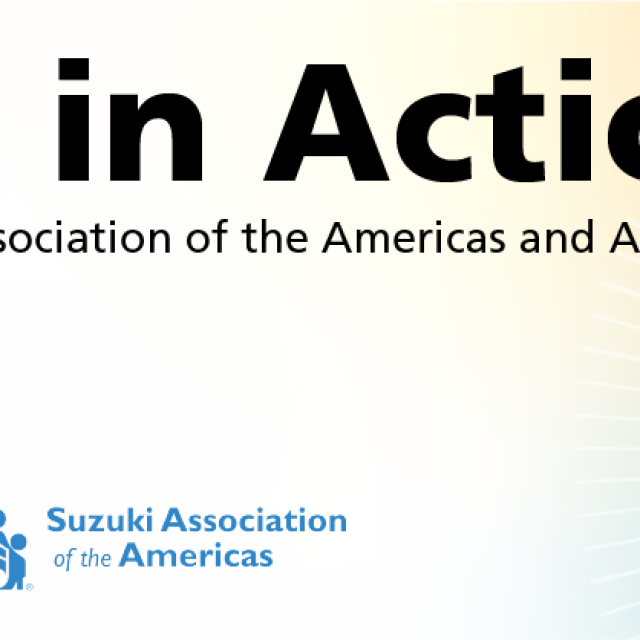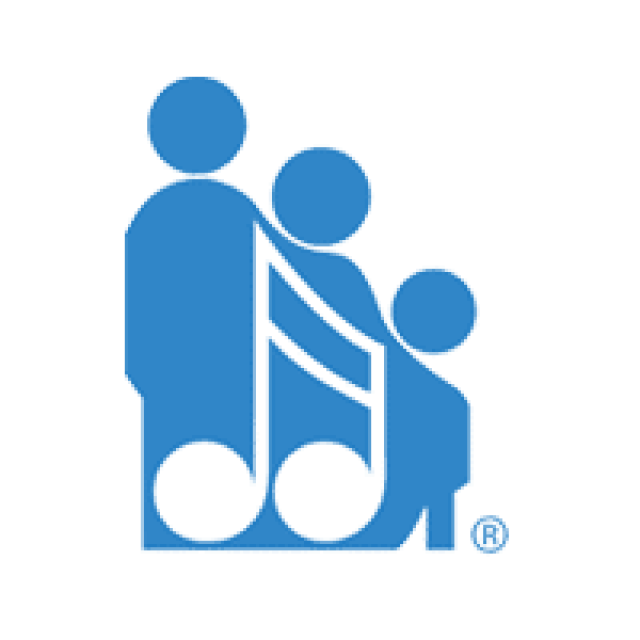Leslie Mizrahi is one of the leading figures in the Latin-American Suzuki community. Since first encountering the Suzuki Method as a piano teacher, and later through Early Childhood Education, she went on to found the Instituto Suzuki Vive la Música, a Suzuki school in Mexico City, in 2010. She has served as president of the Mexican Suzuki Association (AMMS) and is still actively involved in its leadership. She brings her extensive musical and administrative knowledge to the SAA’s Board of Directors.
My beginning with the Suzuki Method was a bit slow. It took me a few courses and lots of observation to begin understanding this new educational paradigm. My first mentor was Francoise Pierredon, who focused on producing a beautiful sound from the start. It was totally new for me, and I couldn’t really understand how to accomplish it at first. Two years after I took ECC and Units One through Three, I met Caroline Fraser in a practicum course. That was a real eye opener! I was able to understand the amazing depths of Dr. Suzuki’s philosophy and the great influence that the Suzuki Method could have on families and children in Mexico, my country, a country in such great need of “nurturing with love."
My initial focus was on group lessons and building a Suzuki community in my country through my involvement in the Mexican Suzuki Association (AMMS). An important part of my training was done in Peru, which also served as a role model to us in Mexico.
As I continued growing in the Suzuki approach, I came to realize that we actually teach parents, and parents teach their children through their loving example and positive approach. The role of teacher then took a totally different dimension, one of great responsibility, and of a great opportunity to touch and change lives. Most of all, it allowed me the opportunity to give every child the path to grow a beautiful heart and to develop wonderful skills, and not only to some “chosen” ones.
I embraced that the Suzuki Method uses music as a character forming tool, always through love and parental involvement, where family values are reinforced and a beautiful bond between parent and child is built. Therefore, I decided to continue my very extensive training to teach myself first, and then to give as many children as possible the opportunity to learn with the Suzuki Method in a loving and caring environment while building professional skills on an instrument from the start.
Can you talk about your experiences with Suzuki Early Childhood Education?
I love the early childhood program! It is amazing how quickly babies learn when exposed to the right environment and to repetition, but most of all, to the love and attention of their parents as they bond together through music.
As I mentioned before, the Suzuki Method is truly parent education, which is most evident in the early childhood program. It’s about teaching parents how to observe their child’s development in all areas, not just music, but their social and emotional skills as well. Most importantly, SECE enables parents to appreciate the uniqueness of their child and instills an awareness that each child learns at their own pace. Parents begin creating a music environment and learning about the importance of their loving example, not only for learning music but for every other aspect of their child´s upbringing.
Additionally, SECE allows children to build the skills that are cornerstones of the Suzuki Method. Repetition and layers give parents an understanding of the importance of accumulative learning, while ear training and listening facilitate a natural transition to learning an instrument. Their teachers will greatly appreciate receiving such parents and children when their pre-twinklers begin their instrument program.
What elements from the other teaching philosophies that you’ve studied (Orff, Dalcroze, and Kodály) do you find most influential in your own teaching?
I became interested in learning these three music pedagogical approaches after taking several courses from Caroline Fraser. I wanted to know more about these tools that she combined in her teaching. So, I took the introductory course of Dalcroze, which taught me the importance of movement with sound, using your body to express the sound, which helps in becoming more musical.
The Orff experience was so wonderful in understanding ensemble music and the importance of training as an individual first, and then as a part of an ensemble. It provided me with another music teaching approach through different instruments—xylophone and flute—as teaching and ensemble tools.
Kodály was an amazing challenge to improve my own musical skills and enhance my musicianship. It is an amazing tool for teaching music reading from the preschool level. I found that the Kodaly and the Suzuki methods have a lot in common, such as repetition, learning though layers, and accumulative learning.
With your experiences as a leader of the Suzuki teaching in Mexico, what aspects of the Suzuki teaching resonate particularly well with your community?
I think that the Suzuki Philosophy is not yet understood widely in the music education community in Mexico. Many people don’t perceive it as a “true” music method, mostly because traditional teachers are ignorant of the method and they feel threatened, so they attack it by saying that children don’t learn how to read music. But little by little, as Suzuki students enter music conservatories and the professional music world, and local Suzuki teachers are becoming Teacher Trainers, the Suzuki Method is starting to gain more credibility, and its footprint is expanding.
In Mexico, we have had the opportunity to rely on the creation of Suzuki recognized schools. These schools have invested in bringing teacher trainers to their festivals and involving teachers and families. They serve as the Institutes do in the USA and Canada, except they are held throughout the year and with each school’s own resources. These schools are really “partners” of AMMS, as they help to spread the deeply needed values of the Suzuki Philosophy.
I think that every aspect of the Suzuki philosophy resonates in our country, but there are so many things to take care of prior to being able to become a vibrant Suzuki teacher. The first of these is in supporting music education and music teachers in the country, because of lack of resources from the government. Many teachers need extensive training but can’t afford it, and some of them come from a limited musical education background.
What led to your founding of the Instituto Suzuki Vive la Música, and what are its guiding principles?
I started my Suzuki piano program in a school in Mexico where I taught school music. After a few years, I realized it was very important to implement the Method in its entirety for better results, which meant having two pianos side by side and the optimal bench and footrest. Additionally, I wanted to be able to hold parents’ workshops and involve parents before their child began formal lessons, such as giving three free lessons for parents to experiment and learn the beginning steps before their child begins. A school would allow my students receive master classes at teacher training courses and attend of Festivals and Encuentros. All of this made me open my own Suzuki school, starting with only piano at first, and then adding other instruments such as violin, cello, guitar, flute, Suzuki Voice, and Early Childhood music.
I started doing summer music school so that the students wouldn’t stop practicing during the summer, and added other disciplines—art, acting, dance choir, and yoga—to the summer camp activities. Some of these activities became part of the school year activities as well.
In 2011, I founded a yearly festival, and we will now offer the twelfth edition of our festival. In the fourth edition of the festival, we offered twelve different training courses, including courses in piano, violin, guitar, cello, flute, Early Childhood Music, and Kodály. It also featured a children’s choir for all the participants, master classes, play ins, and created a space for different ensembles and orchestras to perform. All of this helped the Suzuki community in Mexico and Latin America bond, grow, and have an enriching experience.
It is important to mention that all of these festivals have been done with my own personal resources and staff. They are an ongoing gesture of appreciation and gratitude for all that I have received from my Suzuki mentors who touched and changed my own life. I am continually grateful to them, and continually inspired by my deep belief that the Suzuki philosophy can change the world and make better citizens, human beings, and society.
What skills and ideas do you find to be most important as the director of a Suzuki program?
Community, bonding, and collaboration. Just like children learn from one another, teachers learn so much from sharing their experiences, their difficulties, and their successes. This all happens in a loving and caring environment where we can all learn from each other, similar to the sharing and growing that occurs in training courses. We become a family, and as we put into action what we teach, we become a role model for our students and their families.
What do you hope to accomplish as a member of the SAA board?
Before I answer this question, I would like to talk about my work at the Mexican Suzuki Association and with the Latin-American Associations. Part of my own growth in the Suzuki Method happened thanks to the Peru Festivals and Encuentro. We have held three National Encuentros in Mexico, in beautiful historical cities: Guanajuato, Morelia, and Oaxaca. All of these were unforgettable experiences that marked everyone’s lives, especially the children, some of whom have pursued a musical career and now are giving back to the community!
More broadly, I directed the First Suzuki Convention of the America’s, which gathered close to a thousand participants, but more importantly, one hundred teachers and parents from Suzuki programs. It was amazing to have students playing side-by-side in an orchestra, coming from twenty-seven different countries, ages eight through twenty, sharing one common language: the Suzuki Method and its loving principles.
As a member of the Suzuki Board, I would like to represent the Latin-American Suzuki community, and to find ways to share its rich cultural heritage and, of course, music. I would also like to inspire and be inspired by the larger community of the Americas, to give support to teachers through more training opportunities, so that each one may reach out to more students which will benefit from what I call the “Suzuki experience.”
I would like to facilitate more conventions and gatherings, and to find all the possible funds to accomplish it! Another important part of my role is to be in touch with the Latin-American country associations and to mentor other countries that are creating their local Suzuki Associations.
I want to take this opportunity to thank the SAA board members and staff and to all the pioneers who believed that the Suzuki Method could grow in Latin American; the teacher trainers that have given their time and knowledge; the families that have donated instruments; and everyone whose donations have made training opportunities possible for many teachers in Latin America.
My greatest wish is to be able to be a link, a bridge, that will bring our whole region closer, not only Latin America but Canada as well, whom I’ve also worked closely with. This will make a stronger SAA with more and more teachers receiving training, reaching out to every corner of our great region, expanding our Suzuki vision, and changing lives through Suzuki.








